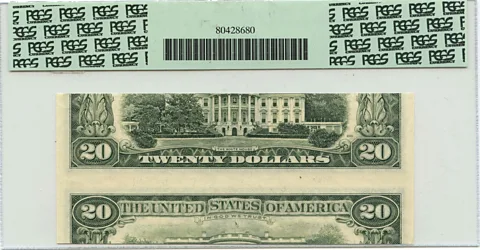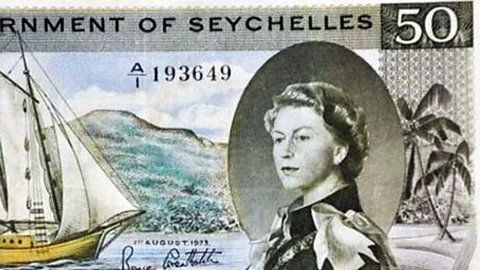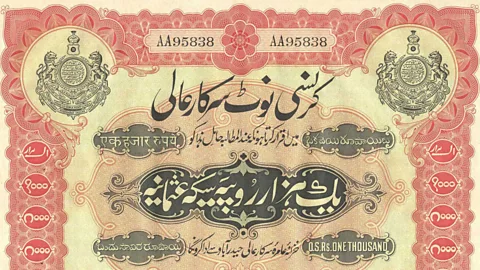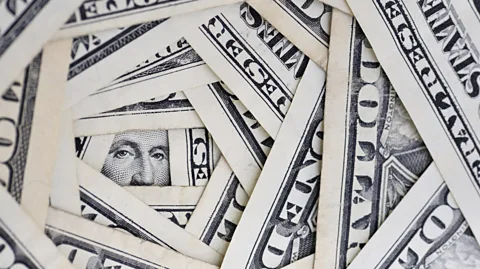Which banknote has ‘sex’ secretly written on it?
 Alamy
AlamyOne day in 1967, 12-year-old Rezwan Razack was nosing through his grandfather’s iron safe in Bengaluru, India, when something unusual caught his eye. It was a wad of banknotes with the word ‘cancelled’ stamped on each.
Amongst the bundle were a few Reserve Bank of India notes with a portrait of King George VI on the front. They had been cancelled with a rubber stamp reading “Pakistan Note Payment Refused”. The little boy’s find triggered a lasting curiosity about paper money that couldn’t be used as legal tender.
“I always used to wonder how Reserve Bank of India notes could be Pakistan money,” said Razack, who later learned that India’s central bank printed money on behalf of Pakistan for some time after Partition cleaved British India in to two countries.
Soon after, while visiting his cousin’s house, he found some British India banknotes, India’s pre-independence currency. These became Razack’s starter collection and sparked a lifelong passion.
“I pestered my grandfather to give me the antique banknotes that were in his safe,” he said. “Sensing my enthusiasm, he readily parted with his treasure.”
As time passed, Razack’s love of rare banknotes blossomed, leading him to become a researcher and scholar. After 10 years of dedicated research, Razack, who now runs a successful construction business in Bengaluru and also serves as chairman of the Indian chapter of the International Bank Notes Society, published a revised edition of The Standard Reference Guide to Indian Paper Money.
 Rekha Chandrabhanu
Rekha ChandrabhanuRazack’s personal collection has a specimen of every type of Indian paper currency issued since 3 September 1812, when the Bank of Bengal issued Sicca rupees, the earliest Indian banknotes. The current market value of notes in his collection range in value from $100 to $50,000, said Razack who declined to reveal his collection’s total worth.
But collections don’t need to focus on just one country’s currency. With globalisation, the ease of travel and greater access to traders and foreign currency markets, collectors can now track down gems a lot more quickly. The market is flooded with banknotes consigned to history due to political, security, fiscal and technical reasons. The question is: which ones are worthy or worthless?
What to look for?
Apart from various governments’ decisions to discontinue certain banknotes or stop issuing higher denominations to combat counterfeiting, banknotes are pulled out of circulation typically due to printing errors — wrong signature, numerical inaccuracy, misprints, misspellings and misrepresentations.
Truly rare and historically significant banknotes are the most desirable specimens and tend to command a market price that far exceeds their face value.
For instance, the most sought-after US error notes are double denomination bills, which means the front shows a $10 note, and the back shows a $20 note, said California-based Fred Weinberg, a dealer in major error coins and paper currency. “These notes can be worth $20,000 to $35,000 each, depending on the series and the condition of the note,” he said.
Similarly, rare specimens of pre-Euro, old European currencies that were phased out since the formation of the single-currency European Union in 2002 can now be worth a pretty penny. A report in the Irish Independent pegged the value of old Irish banknotes from the “Ploughman” or “Lady Lavery” series, for instance, as high as 5,000 euros ($5,430) each.
 Fred Weinberg
Fred WeinbergThe global market is growing for rare banknotes in good condition, said Jared Stapleton, director at Toronto Coin Expo, Canada’s premier coin and banknote show. “Even though the world’s economy is in a state of uncertainty, rare banknotes are still selling for top dollar,” he said.
In the Indian market, some of the hardest to find, and most valuable, currency notes are those that were printed during the French, Portuguese and British rules in India. Also rare and sought-after are the rupee bills that the Government of India issued in 1959 for exclusive use in the Persian Gulf countries by the Haj pilgrims from India. “These notes were issued only once,” said Razack and can now command as much as $30,000, for a 100 rupee bill on the open market. “The most remarkable feature is the colour of these notes, which is different from the existing notes in circulation in India at the time. The colour differentiation was to identify that these notes were not considered legal tender in India.”
Most coveted
John Millensted, currency specialist at the British auction house Bonhams, said the rarest pieces tend to be specimens or trial pieces which aren’t necessarily taken up as a design for a banknote. “Most banknotes with over 40 years of age hold their value,” he said.
Sometimes it’s the simplest notes that can become most collectable. For example, a £1 ($1.44) note from World War I with an overprint in Arabic, used by British forces in Turkey in 1915, can fetch up to £8,000 ($11,549), even though the note is quite plain, Millensted said.
 BBC News/Duke's of Dorchester
BBC News/Duke's of DorchesterApart from good condition and limited print runs, a note’s quirkiness has appeal. One such example is the Seychelles banknote of 50 rupees that has the word “sex” written secretly in palm trees. Another is the Canadian $2 bill which was sold at a public auction for Canadian $13,000 ($9,336) because it had the signature of the wrong official on it, said Stapleton who also runs his own store, Metro Coin & Banknote Company, in Toronto. “During the printing process, a few sheets with the wrong official’s signature got into the serial numbering process out of sequence, creating rare signature notes,” he said.
However, it’s the 1954 “Devil’s Head” series, which was only produced for about a year and a half, that remains the most coveted of obsolete Canadian banknotes. One of those, a Canadian $2 bill, was sold at an auction for a staggering $10,000 Canadian dollars ($7,410) a few years ago, Stapleton said. The series triggered controversy because in the engraving of the portrait an area of the Queen's hair gives the illusion of a grinning devil. “The Devil’s Head notes remained in circulation to wear out, but are highly desirable as they were only produced for a short time,” Stapleton said.
A future investment
If you are able to put a few perfect uncirculated notes — newly minted, crisp and clean bills — of a current series aside for face value, they may have the potential to be collectable eventually, said Stapleton.
Amongst British paper money, said Millensted, early British Provincial banknotes still represent a good investment. “These will have a good age to them already — about 200 years old — and can still be picked up reasonably cheaply,” he said.
Those into colonial paper currency may find a treasure in the bills issued by Presidency Banks of colonial India — Bank of Bengal, Bank of Madras and Bank of Bombay — and the portrait notes of Queen Victoria, King George V and VI, which, said Razack, will soon be extinct. “An avid collector should buy right now as these would be treasured pieces in the years to come,” he said.
 Rekha Chandrabhanu
Rekha ChandrabhanuWhere to buy and sell
“The best sites for people to learn about demonetised banknotes are auction websites such as Baldwin’s (UK), Lyn Knight Currency Auctions (USA), Noble Numismatics (Australia) and Todywalla Auctions (India),” Razack said.
Online retailers (eBay, Amazon, and German trader Banknoten), currency dealers and galleries (Certified Coin Exchange, Inc., Metro Coin and Banknote, George LaBarre), and numismatic shows (Toronto Coin Expo in Canada, ANDA Money Expo in Australia and UK Coin Fairs) are other useful sources.
Also, never underestimate the power of word of mouth. Friends, acquaintances and relatives all contributed to Razack’s collection. “There wasn’t a person that I wouldn’t ask if they had by any chance old paper money lying around in their cupboards,” he said.
 iStock
iStockSometimes it’s sheer serendipity. There’s no shortage of stories where people discovered highly valuable collectibles, including dated currency bills, in attics, books, dressers and photo frames of old or deceased family members.
How to care for them
Regardless of their age or rarity, banknotes that are damaged — torn and tatty, or frayed and faded — aren’t worth the paper they are printed on. “They need to be stored in special holders made by companies like Lindner or Lighthouse and protect them from humidity and human handling,” Razack said.
These plastic holders that cost less than $50 “protect the note from fingerprints, folding, and stains,” said Weinberg. “Once placed in the holder, you shouldn’t handle the note too often.” Banknotes that are damaged — torn and tatty, or frayed and faded — aren’t worth the paper they are printed on.
Handling a banknote too much can transfer the dirt and oil from your hands onto the note and can cause folds and creases that trap gunk.
Stapleton cautioned against the classic rookie mistake: treating and tampering with a banknote. “Don’t wash or press a banknote, or try to erase any marks on the note, or trim the edges off,” he said noting doing so takes away the note’s original sheen, which is detrimental to both its grade and value.
The bottom line
Although it’s a passion project, Millensted said “serious collectors want to make sure they have bought wisely and that there is a hope of a profit when the time comes to sell.”
The good news, said Stapleton, is that “over the last quarter century, your average return on investment has been ten times.”
And while Razack said his collection would never be up for sale, he admitted: “Over time this has the potential for value growth, which is far greater than any other asset.”
